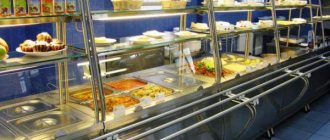The popularity of catering outlets will never fade, because human laziness and love for food are eternal. Indeed, not everyone, having desired the Stolichny salad, cutlet Kiev and Prague cake for dessert, can afford to rush to the store in order to buy everything they need and lock themselves in the kitchen, cooking for several hours. The harsh reality of work, traffic jams and fatigue dictates its own rules, but you still want to eat delicious food. Entrepreneurial people who have managed to build a serious business out of a successful kitchen have been successfully making money on these human weaknesses for many years. How to correctly calculate the cost of a meal in a canteen so as not to work at a loss, or, conversely, not to scare away potential customers with exorbitant prices? At the same time, golden hands are not enough for success, because the market and competition dictate their own rules. It would seem - a canteen and a canteen, what can you earn there? However, people’s attachment to the classics, when they were still cooking according to the “Book of Tasty and Healthy Food,” is worth a lot.
Content
- State and development of the market
- Where to start opening a canteen? Format selection
- Concept
- Canteen business plan
- Consulting
- Dining room
- Dining equipment
- Canteen staff selection
- Registration
- Taxation
- Profitability and payback
Note: This business plan, like all others in the Business Plans section, contains calculations of average prices, which may differ in your case. Therefore, we recommend that you make calculations for your business individually.
In this article, we have compiled a detailed business plan for a canteen with calculations.
State and development of the market
The restaurant industry is one of the first to bear the brunt of the economic crisis. People eat out less often, deny themselves traditional Friday-Saturday entertainment, and minimize formal trips to restaurants. Considering all this, does it make sense to start your own business in HoReCa now? We answer: “Yes!”
How the market has changed
— Simple establishments designed for a wide audience began to open. The dining room is a great example of this.
— Interesting projects now come to the target audience on their own. They are located not only in different areas.
— They began to take the opening of a food outlet more seriously and thoughtfully. Beginning entrepreneurs use the services of expert consultants, turn to specialized companies for comprehensive equipment of enterprises, and are afraid of entering the market independently without the support of professionals.
Arguments for opening a canteen
— The corporate catering industry is currently practically not covered. Catering in kindergartens, schools, camps, hospitals is not overloaded with competitors and has excellent development prospects.
— Canteens are well known to consumers; they do not need to be introduced to the format.
— The menu in the canteens is designed for a wide audience.
— Average check — 200 rub. and a large selection of dishes - at least 50 per day - make the dining room accessible and attractive for students, the working population, and retirees.
— Canteens always have the possibility of additional income - banquets, catering, working for a client “from the street.”
Business plan for a canteen for 20 seats
Opening a canteen with 20 seats will be an excellent option for beginning entrepreneurs who are not ready to invest a huge amount of millions of rubles in their first business. Let's calculate how much money we need to open a business and how much we will have to spend monthly to keep it running.
| Name | Sum |
| Initial costs | |
| Equipment | RUR 670,000 |
| Business registration | 5.000rub |
| Room renovation | RUB 300,000 |
| other expenses | RUR 50,000 |
| Total: | RUR 1,025,000 |
| Monthly expenses | |
| Staff salaries | RUR 130,000 |
| Renting premises | 40.000rub |
| Communal expenses | 20.000rub |
| other expenses | 10.000rub |
| Total: | RUR 200,000 |
Let's assume that the average bill in your canteen is 200 rubles, 40% of this will go towards food costs. This means that from each order you will earn 120 rubles. The canteen will be open for 8 hours and every hour the canteen will be half full. Income without monthly expenses for the month will be 297,600 rubles. From here we subtract monthly expenses and it turns out that the net profit will be 97,600 rubles, and the payback of the business will be 11 months.
Where to start opening a canteen? Format selection
If previously a canteen was associated with a certain institution (factories, educational institutions) and was closed to the mass consumer, now this format is close to a cafe, but relies on low prices, simple dishes and drinks, and unpretentious design.
The dining room comes in different versions
City canteen. Provides catering services for any visitor. Located next to large organizations and educational institutions. Conducts banquets and catering.
Dining room in the business center. Located in the corporate catering segment. Serves employees and visitors from the street at certain hours. Serves as a place for corporate parties and business negotiations.
A canteen in an administrative, medical or educational institution. Works for a limited audience.
Dining room in a shopping center. It is part of a food court or food court. Occupies a larger area than other operators, designed for 40-50 seats.
For an example of a business plan for a canteen, we will take an urban format with 50 seats - that’s 400 people per shift. Area - 180 m². This canteen operates on the open market and provides food and banquet services.
Motivation for visiting a city canteen
- Natural hunger relief
- Lunch break
- Family lunch or social gathering
- Business conversation
- Ceremonial event
Technological calculations for the canteen (page 1 of 3)
1. Technological part
1.1 General part
The technological part of the canteen project was developed in accordance with regulatory design documents:
SNiP 2.08.02-89* “Public buildings and structures”;
SNiP 2.09.02-85* “Industrial buildings”;
SNiP 2.09.04-87* “Administrative and domestic buildings”;
SanPiN (SP) 2.3.6.1079-01 “Sanitary and epidemiological requirements for public catering organizations...”;
PPB-01-03 “Fire Safety Rules of the Russian Federation”
NPB 105-03 “Definition of categories of premises, buildings and outdoor installations based on explosion and fire hazards”;
NPB 110-03 “List of buildings, structures, premises and equipment subject to protection by automatic fire extinguishing installations and automatic fire alarms”;
NPB 104-03 “Warning systems and management of evacuation of people during fires in buildings and structures”;
“Standards for equipping public catering establishments with commercial, technological and refrigeration equipment”;
MGSN 4.14-98 “Catering establishments”.
SanPiN 2.2.2.542-96 “Hygienic requirements for video display terminals, personal electronic computers and work organization”
1.2 Dining room for 30 seats, technological part
1.2.1 Determination of main technological indicators
The main technological indicators of the project are the number of consumers, the operating mode of the enterprise, the quantity and distribution of manufactured products, the consumption of raw materials for production, and the number of production personnel.
Initial data for calculating the main technological indicators:
According to GOST R 50762-95 and the design specifications, the dining room is classified as a general dining room
Three meals a day are provided in the canteen
The number of consumers served for one meal per day is 100 people
Form of service – self-service
Type of production - the canteen works on raw materials
The capacity of the hall is 30 people.
Determining the number of consumers during the day.
Based on the capacity of the hall and the type of dining room and the number of consumers, we assume a double turnover of seats.
The number of consumers served per 1 hour of operation of the enterprise is determined by the formula
Nch =
(P*j*x)/100,
where Nch is the number of consumers served per hour, people; P — number of seats in the hall, seats; j is the turnover of seats in the hall during a given hour; x — hall load at a given hour, %.
Table 1. Determination of the number of consumers during the day
| Opening hours | Place turnover per 1 hour, times | Average room occupancy, % | Number of people eating, people |
| Breakfast | |||
| 7.00 — 7.30 | 2 | 50 | 15 |
| 7.30 — 8.30 | 2 | 80 | 48 |
| 8.30— 9.30 | 2 | 80 | 48 |
| Dinner | |||
| 12 —13 | 2 | 80 | 48 |
| 13 — 14 | 2 | 90 | 54 |
| 14 — 14.30 | 2 | 50 | 15 |
| Dinner | |||
| 17.30 — 18 | 2 | 50 | 15 |
| 18 — 19 | 2 | 80 | 48 |
| 19 — 20 | 2 | 90 | 54 |
| Total | 2 | 345 | |
The average number of consumers per type of meal (breakfast, lunch or dinner) is 330/3=115 people. This is 10% more than the specified number of consumers. We accept 10% reserve
Canteen opening hours
According to Table 1, the opening hours of the canteen are from 7.00 to 20.00, which is 13 hours. We accept the start time for production personnel to be 6.00. End time 22.00. One hour before breakfast is spent preparing it, cleaning the premises, etc. One hour after dinner is taken for cleaning the premises, washing dishes, etc.
We accept the operating mode of the canteen - two shifts. Shift duration is 8 hours.
Determining the number of dishes.
Since the dining room provides three meals a day (breakfast, lunch, dinner), the number of dishes is determined for each mode separately using the formulas
nз = Nз * mз,
no = No * mo,
nу = Nу * mу,
where nz, po, pu - the total number of dishes sold during breakfast, lunch and dinner, respectively; Nз, No, Nу - number of consumers during breakfast, lunch and dinner (Table 1); mз, mo, mу - coefficients of food consumption during breakfast, lunch and dinner.
The total number of dishes is determined by the formula
n = nз + no + nу
Table 2. Determination of the number of dishes
| Total number of dishes | Meal consumption rate | Total |
| Breakfast | 2 | 222 |
| Dinner | 3 | 351 |
| Dinner | 2 | 234 |
| Total | 807 |
The total number of dishes will be n = 807 dishes.
Table 3. Determination of the number of individual types of dishes produced by the canteen, according to the percentage of dishes
| Breakfast | Dinner | Dinner | ||||||
| % of total quantity | % of this group | number of dishes | % of total quantity | % of this group | number of dishes | % of total quantity | % of this group | number of dishes |
| Cold dishes | 35 | 67,2 | 20 | 70,2 | 35 | 81,9 | ||
| salads (fish, meat) | 60 | 40,32 | 60 | 42,1 | 60 | 49,1 | ||
| dairy products | 20 | 13,4 | 20 | 14 | 20 | 16,4 | ||
| sandwiches | 20 | 13,4 | 20 | 14 | 20 | 16,4 | ||
| Soups: | 30 | 105,3 | ||||||
| Second hot dishes: | 50 | 96 | 40 | 140,4 | 50 | 117 | ||
| meat | 10 | 9,6 | 40 | 56,2 | 30 | 35,1 | ||
| fish | 10 | 9,6 | 40 | 56,2 | 30 | 35,1 | ||
| vegetable | 30 | 28,8 | 20 | 28,1 | 20 | 23,4 | ||
| egg and curd | 50 | 48 | 0 | 0 | 20 | 23,4 | ||
| Sweet dishes | 15 | 28,8 | 10 | 35,1 | 15 | 35,1 | ||
| Total | 222 | 351 | 234 | |||||
Calculation of consumption of raw materials and culinary semi-finished products.
The calculation is based on the corresponding physiological norms of food products for a given group of consumers. These standards were developed and approved by the Institute of Nutrition of the USSR Academy of Medical Sciences.
The amount of raw materials (kg) is determined by the formula
where N is the number of consumers at a given enterprise during the day (we take the number of consumers equal to the average number of consumers - 115 people per day); g is the physiological norm of a given type of raw material per person per day, g.
Table 4. Calculation of raw materials according to physiological standards
| Raw materials | Norm, g | Weight, kg |
| Bread | 550 | 55 |
| rye | 200 | 20 |
| wheat | 300 | 30 |
| baking | 50 | 5 |
| bread in terms of flour | 375 | 37,5 |
| wheat flour | 10 | 1 |
| starch | 5 | 0,5 |
| cereals and legumes | 80 | 8 |
| pasta | 40 | 4 |
| lard | 10 | 1 |
| margarine | 10 | 1 |
| vegetable oil | 20 | 2 |
| butter | 60 | 6 |
| milk | 125 | 12,5 |
| sour cream | 25 | 2,5 |
| cottage cheese | 30 | 3 |
| cheese | 20 | 2 |
| egg | 1 | 100 |
| meat | 250 | 25 |
| sausage | 20 | 2 |
| canned meat | 10 | 1 |
| fish | 80 | 8 |
| canned fish | 20 | 2 |
| seafood | 10 | 1 |
| sugar and confectionery | 120 | 12 |
| tea | 5 | 0,5 |
| coffee | 3 | 0,3 |
| cocoa | 2 | 0,2 |
| potato | 400 | 40 |
| bulb onions | 60 | 6 |
| greenery | 80 | 8 |
| tomatoes | 50 | 5 |
| cucumbers | 50 | 5 |
| cabbage | 60 | 6 |
| carrot | 60 | 6 |
| beet | 60 | 6 |
| garlic | 5 | 0,5 |
| tomato paste | 25 | 2,5 |
| pickles | 50 | 5 |
| dried fruits | 30 | 3 |
| fruits | 200 | 20 |
| juices | 100 | 10 |
| lemon | 10 | 1 |
| salt | 30 | 3 |
| spices | 8 | 0,8 |
| yeast | 15 | 1,5 |
| sauces | 10 | 1 |
Calculation of the number of production and hall employees.
For each workshop and canteen premises, the number of workers performing technological operations related to the production and sale of products, washing dishes, containers and equipment, and servicing consumers is determined.
The number of production workers in workshops is calculated according to time standards (per unit of finished product).
The number of production workers directly employed in the production process (main workshops) is determined according to time standards in accordance with the formula
where n is the number of dishes prepared per day, pcs, kg, dishes; t is the standard time for manufacturing a unit of product, s; T is the length of the working day for each worker, hours; λ is a coefficient that takes into account the growth of labor productivity (λ = 1.14), used only when the process is mechanized.
Concept
This is a document that outlines every step of opening a dining room. The concept answers the following questions:
Where will the establishment be located?
- Choosing a location and premises
- Assessment of passability, transport accessibility, visibility from the street and roadway
- Assessment of the condition of the premises, utilities, sanitary conditions
- Design and equipment
What target audience will it be designed for?
- Client characteristics
- Audience needs
- Channels of communication with the audience
Features of the accommodation area
- Infrastructure
- Competitors
- Availability of office centers, universities, streets with shops nearby
Staffing table
- Self-service or waiter service
- Working with semi-finished products or own production
- Recruiting and training
What additional services should I provide?
- Banquet menu development
- Catering options
- Organization of food delivery and takeaway packaging
Dining concept
The concept is a document that describes in detail each section of opening a dining room. To create a competent concept, set your goals:
Location of the establishment:
- Select a room;
- Assess the location in terms of transport accessibility. Will the establishment be visible from the street or roadway?
- What is the condition of the premises: utilities, sanitary conditions;
- Design and equipment issues.
The target audience:
- Describe your client;
- Assess the needs of your potential audience;
- Means of communication with visitors;
- Determine the client's price expectations.
Location area:
- Assess the infrastructure;
- Think about possible competitors;
- Are there business centers, educational institutions, shopping centers, small shops nearby?
Staffing:
- Service by waiters or clients themselves;
- Semi-finished products or own production;
- Recruiting employees or training at your own expense.
Additional services:
- Availability of a banquet menu;
- Catering work;
- Food delivery or the ability to pack a dish with you.
Dining room menu plan
The dining room menu plan includes:
- Several types of salads (5-10)
- Several types of soups (2-5)
- Several types of main dishes (meat, chicken, fish - up to 10),
- Several types of side dishes (5-7),
- Several types of desserts and sweets (2-10),
- Several types of drinks (water, juice, compote, tea, coffee, cocoa).
Choosing a dining room
Most often, they rent space for their own business. The rent depends on the territorial features. For example, in the Moscow region, the rental price is 10,000 rubles per square meter. The area of the Third Transport Ring dictates a price of 50,000 rubles per square meter.
The best room for a dining room would be one in the common area of which there is already a store or catering facility.
Repair
The estimated area of the premises is 180 sq.m. The premises need major renovations and cosmetic finishing. Repair work in the VIP category costs 15,000 per square meter; for cosmetic work, teams of workers charge 1,500 per square meter.
Here's everything you need to know about space for your business.
Dining room
Renting is the most common way to obtain the use of the selected premises. The rental price depends on the territorial features. The Moscow region asks for from 10,000 rubles. per m², and in the area of the Third Transport Ring the price will rise to 50,000 per m².
For the dining room, we recommend choosing a room that already housed a catering facility or a store. Considering the area - 180 m² - major repairs and finishing will result in a tidy sum. For repairs in the VIP category, crews ask from 15,000 rubles. per m², and cosmetic will cost only 1,500 per m².
- Engineering and design
Technological and engineering design prepares the premises for full operation. What is included in the list of works?
Engineering design involves the development of projects for all communications - ventilation + air conditioning, water supply + sewerage, electricity, as well as an architectural design. Again, if the room has a specialized purpose, you can save on the engineering project. If not, then pay at least 60,000 rubles for a set of works.
Process design is the selection of professional equipment for production tasks, the development of a scheme for its installation and connection to utility networks. It is impossible to do without this type of design. Cost - 200 rubles. per m². gives a technological project to its customers when ordering equipment.
The design project of the premises includes the development of a design concept and 3D visualization, selection of materials and decor, facade design and on-site supervision. A complete design project, including decoration of the surrounding area, will cost at least 200,000 rubles. Shortened - 150-160,000 rubles.
- Corporate identity and outdoor advertising
The visual image of the dining room is created using a corporate identity. This is especially true for corporate projects. The standard package of services includes: logo development, selection of corporate colors and fonts, development of style-forming elements, development of corporate elements using the example of 3 positions, layout of Logobook - guidelines for using the logo. Cost - 50,000 rubles.
Outdoor advertising is relevant for the urban canteen format. These can be three-dimensional letters, neon signs, light boxes. Each project is calculated individually according to customer requirements.
Required documents for Gospozhnadzor
- OGRN or certificate of entry into the Unified State Register of Legal Entities;
- Unified State Register of Individual Entrepreneurs, also known as an extract from the Unified State Register of Legal Entities;
- Individual tax number;
- Information letter about registration with the Statregister of Rosstat;
- An organization card containing contacts (telephone, fax, address);
- Premises rental agreement;
- Explication of the premises;
- Documents according to which data on the installation of fire alarms is known;
- Alarm maintenance contract;
- Certificate that the person responsible for fire safety has completed the necessary training;
- Availability of an order appointing a separate employee who will be responsible for fire safety.
Dining equipment
For a dining room with 50 seats you will need (prices are in rubles):
Distribution line “Patsha”, Chuvashtorgtekhnika (ABAT)
- Cutlery counter - 25,200
- Refrigerated display counter - 153 900
- Warmie counter for first courses - 48,200
- Baking table for second courses – 70 300
- Hot drinks counter – 33,900
- Rotary module - 28,700
- Cash register — 33,100
- Food warmer for first courses “Convito” – 4,896
Equipment
- Four-burner electric stove with oven - 55 900
- Frying surface (contact grill) ERGO – 39 600
- Electric tilting frying pan - 79 900
- Electric cooker - 85,000
- Rice cooker ERGO – 2,376
- ERGO single-burner pancake maker – 14,760
- Microwave oven “Convito” - 14,184
- Boiler "Convito" flood type - 7 560
- Refrigerating cabinet ARIADA – 45 602
- Freezer cabinet ARIADA – 53 724
- Bread slicer AHM-300T — 65,000
- Mixer ROBOT COUPE Mini – 21 420
- Blender ERGO – 12 240
- Mixer KITCHEN AID – 54,900
- Potato peeler MOK-300M — 38,500
- Meat grinder ERGO – 21 240
- Single-section washing bath (5 pcs.) - 19,540
- Two-section washing bathtub - 7 348
- Industrial wall table – 4 044
- Hairpin trolley (2 pcs.) - 26,864
- Rack with solid shelves (2 pcs.) - 17 010
- Solid wall shelf (2 pcs.) - 3,626
- Wall shelf for drying dishes - 2 469
- Exhaust umbrella - 9 846
- Touch hand dryer ERGO – 2 807
- Washing bath (washstand) (5 pcs.) - 26,250
Kitchenware and utensils
- Gastronorm container Luxstahl stainless steel GN 1/1 (4 pcs.) - 2,492
- Luxstahl aluminum frying pan (2 pcs.) - 1,990
- Cast iron frying pan with wooden handle Luxstahl – 1,080
- Boiler 25 l professional Luxstahl (3 pcs.) - 11 232
- Deep tray 600x400x48 mm (3 pcs.) - 1,944
- Chef's knife 200 mm Profi Luxstahl – 590
- Utility knife 145 mm Profi Luxstahl (2 pcs.) – 666
- Vegetable knife 75 mm Profi Luxstahl (2 pcs.) – 530
- Polypropylene cutting board (2 pcs.) - 2,686
- Beech cutting board (3 pcs.)— 1,410
- Form for baking/displaying a side dish or salad “Square” (2 pcs.) – 268
- Ladle 250 ml Luxstahl (2 pcs.) – 548
- Universal pliers 300 mm (2 pcs.) – 182
- Culinary bamboo corner spatula (2 pcs.) – 118
- Four-sided combined grater large – 94
- Whisk 280 mm - 220
- Table tray made of polypropylene 490x360 mm black (40 pcs.) - 3,400
- Set for spices “Family” (salt, pepper) Luxstahl (25 pcs.) – 4,325
- Apron “Moskvichka” red (6 pcs.) – 2,928
- White paper napkin 250x250 mm 400 pcs (10 packs) - 660
Crockery and cutlery (50 pcs.)
- Small round plate “Collage” 200 mm – 2,500
- Deep round plate “Collage” 250 ml – 2,500
- Round salad bowl “Collage” 300 ml – 2,900
- Tea-coffee mug 200 ml – 1,700
- Highball glass 200 ml – 650
- Table fork “Solo” Luxstahl – 2,250
- Table knife “Solo” Luxstahl – 3,550
- Table spoon “Solo” Luxstahl – 2,250
- Tea spoon “Solo” Luxstahl – 1,500
Furniture
- Chair “Viennese” with soft seat (50 pcs.) – 44,000
- Table ST 5 with a chipboard tabletop, lined with plastic (20 pcs.) - 45,900
- Table ST 6 with a chipboard tabletop, lined with plastic (20 pcs.) - 63,000
The cost of the set is RUB 1,339,969. You can find out more about the project on the website
Business plan for a canteen for 50 seats
A canteen with 50 seats is already a more serious business, it is much larger than the previous one, which means that the initial investment and subsequent net profit will be greater. Let's do the calculations.
| Name | Sum |
| Initial costs | |
| Equipment | RUR 1,340,000 |
| Business registration | 5.000rub |
| Room renovation | 400.000rub |
| other expenses | RUR 50,000 |
| Total: | RUR 1,795,000 |
| Monthly expenses | |
| Staff salaries | RUR 260,000 |
| Renting premises | RUR 70,000 |
| Communal expenses | RUB 30,000 |
| other expenses | 10.000rub |
| Total: | RUB 370,000 |
Despite the fact that this is more of a canteen, it still remains an establishment with cheap food. Therefore, we cannot increase the average check in any way. Such a business will easily generate 150,000 net profit and will pay for itself in 12 months.
Canteen staff selection
The selection of personnel for the canteen begins with the cook-technologist and the production manager. This must be done at the stage of developing the concept and menu of the enterprise. A week before opening, the staff must be fully staffed and trained.
Canteen staff and approximate salary
- Director - from 70,000 rubles.
- Production manager - from RUB 65,000.
- Chief accountant - from 60,000 rubles.
- Accountant-calculator - from 40,000 rubles.
- Forwarding driver - from RUB 35,000.
- Cook-technologist - from 45,000 rubles.
- 2 general-purpose cooks - from RUB 40,000.
- 2 employees on the distribution line - from 25,000 rubles.
- Cashier - from 25,000 rubles.
- 2 cleaners - from 15,000 rubles.
- 2 dishwashers - from 15,000 rubles.
Salary costs every month - from 435,000 rubles.
Registration
The first step is to choose a form of ownership: or LLC. For a canteen where the sale of alcoholic beverages is not provided - and this is one of the key factors for catering - the individual entrepreneur form is quite suitable.
In Moscow, individual entrepreneurs are registered with a single authority - MIFTS No. 46 for Moscow. Before you begin preparing documents for registering an individual entrepreneur, you need to obtain a taxpayer identification number (TIN). This can be done in advance or during the application for registration.
To register an individual entrepreneur you need
- Application for state registration of an individual as an individual entrepreneur.
- A copy of the passport of a citizen of the Russian Federation.
- A document confirming payment of the state fee in the amount of 800 rubles.
Features of IP
- Registration at place of residence;
- Registration is for one person only;
- No charter, authorized capital, or current account are required;
- A person is liable for obligations with all his property even after the closure of the individual entrepreneur;
- There is no need to account for equipment used as part of business activities;
- You can freely manage funds in your current account;
- IP cannot be sold or re-registered, you can only close the IP and create something new in its place;
- Business decisions are not recorded;
- There is no need to pay tax on property used in business activities.
OKEVD codes for canteen
- 55.30 Activities of restaurants and cafes
- 55.40 Bar activities
- 55.51 Activities of canteens at enterprises and institutions
- 55.52 Supply of catering products
To obtain permission to operate, you must prepare a number of documents for Rospotrebnadzor and Gospozhnadzor.
Documents to Rospotrebnadzor for the canteen
- Certificate of registration of individual entrepreneur
- Certificate of registration with the Federal Tax Service
- Premises rental agreement
- Production control program
- Employee medical records
- Product certificates
- Agreements for garbage removal, solid waste, etc.
Documents to Gospozhnadzor for the canteen
- Certificate of entry into the Unified State Register of Legal Entities (OGRN)
- Extract from the Unified State Register of Legal Entities (USRIP)
- TIN
- Information letter about registration in the Statregister of Rosstat
- Organization card, indicating contacts, tel./fax.
- Lease contract
- Explication of the premises
- Documents confirming the installation of fire alarms
- Fire alarm maintenance contract
- Certificate of completion of fire safety training
- Order on the appointment of an employee responsible for fire safety
How to calculate meals in the dining room. Calculation of the cost of a dish
The popularity of catering outlets will never fade, because human laziness and love for food are eternal. Indeed, not everyone, having desired the Stolichny salad, chicken Kiev and Prague cake for dessert, can afford to rush to the store to buy everything they need and lock themselves in the kitchen, cooking for several hours.
The terrible reality with work, traffic jams and lethargy dictates its own rules, but you still want to eat something tasty. For many years, enterprising people who were able to build a tough business in a successful kitchen have been successfully making money on these human weaknesses.
How to correctly calculate the cost of a meal in a canteen so as not to work at a loss, or, on the contrary, not to scare away potential customers with exorbitant prices? With all this, golden hands are not enough for success, because the market and competition dictate their own rules.
It would seem - a canteen and a canteen, what can you earn there? But people’s attachment to the classics, when they were still cooking according to “The Book of Savory and Healthy Food,” is worth a lot.
On fingers
In truth, cost output is now overestimated, because it is more logical to formulate the final cost of a menu item based on people’s tastes, demand and average market requests, but for internal tracking of costs and leveling of expenses, dish calculation is still recommended.
For example, let’s take one of the currently popular confectioneries of the French standard: the company uses raw materials of the highest quality level with a suitable price tag, uses special equipment for the manufacture of its own products, which is very expensive (for example, the same fully automatic device for tempering chocolate - save on it will not work, because this is fraught with failures and damage to expensive resources), rents a room of the required size, etc., etc. The costing of dishes is spot on, but they cannot reduce costs, because the quality, name and, as a result, demand will suffer, so they have to keep the bar. They also cannot put a moderately high markup on those items that are roads on their own, and those 300% of the cost that are rumored by the population are simply brushed aside. Because what to do? Let's look at the menu that the confectionery offers:
- yeast baked goods;
- cakes and pastries;
- marshmallow candies.
The 1st and 3rd positions in terms of cost, if not cheap, are close to it, while it’s impossible to “screw up” even half of the cakes due to expensive resources. Therefore, the 2nd position is sold significantly cheaper, and the difference is made up by buns and sweets. Moral: calculating the price of a dish is not always based on the purchase prices of its components.
Naturally, a confectionery shop is different from a canteen, but the mechanism for working with final food products is identical.
Where to begin?
Those who are especially lazy can use ready-made online templates that can be found everywhere on the Internet, but they are very general and rather rough to calculate. It would be more accurate to set prices on your own once and stick to them in the future, adjusting based on demand. In order to display the correct calculation of dishes in the dining room, you need to have on hand:
- a completed menu, which will indicate a list of dishes provided by the catering outlet;
- technological maps for each menu item;
- purchase prices of all goods that are involved in the production of menu items.
Menu
A little advice: when choosing dishes for the dining room, don’t go overboard. The very definition of this catering outlet suggests ordinary, unsophisticated food that can evoke nostalgia for the period of the Union. In other words, no sushi.
Well, the wealth of complex positions will make calculating dishes, if not more problematic, then certainly more boring.
A list the width of an encyclopedia is difficult to maintain both at the professional and material level, because it is difficult to find generalist cooks for the canteen, and maintaining a suitable composition of goods on a constant basis is costly.
Technological maps
This term is understood as a document that contains information about all the features of a dish. It includes the following data (not necessarily all, some are selective):
- Duration and specifics of storage of the dish. Conventionally: ice cream at a temperature of -18...-24 oC is stored for 3 months, while bread, at a temperature of +20...+25 oC, is stored for 72 hours;
- nutritional value of the finished dish: number of calories, in some cases – protein/fat/carbohydrate ratio;
- requirements for the sale and serving of finished dishes;
- specifically the recipe itself, which contains the composition and manufacturing method;
- recipe source;
- description of the appearance, principle of decoration of the dish;
- weight of the finished portion.
You can’t misuse the technological map, because the “maybe” and “approximately” working mechanisms will only be fun until the first fine from the supervisory authorities.
You can acquire this document in 2 ways - purchase a ready-made one, which will be made to order for you, or withdraw it without the help of others. The first one is frankly expensive, and there is nothing complicated in the second one, which we will prove below.
Example
Menu item name: Chicken Kiev.
Technological map No. 47.
Type of heat treatment of the dish: roasting.
Expected yield of the finished dish (serving size): 310 g.
Layout of goods per 100 grams of finished dish:
- peeled chicken fillet – 29.82 grams;
- butter – 14 g;
- chicken egg – 3.27 grams;
- bread made from premium flour - 8.88 grams. The expected mass of the semi-finished product at the exit is 50.35 grams;
- cooking fat for frying – 5.21 grams;
- side dish bean (technological map No. 741) or potato (technological map No. 42) - 52.08 grams.
Nutritional value of the dish, its chemical composition and calorie content, recipe
| Name, gr | Amount of nutrients per 100 grams of prepared food | Percentage of nutrient loss during the manufacturing process, % |
| Squirrels | 52, 93 | 4 |
| Fats | 215,34 | 36 |
| Carbohydrates | 56,4 | 14 |
| Calorie content | 2745,1 | 21 |
| B1, mg | 0 | 12 |
| B2, mg | 0 | 4 |
| C, mg | 0 | 51 |
| Ca, mg | 0 | 19 |
| Fe, mg | 0 | 5 |
The beaten chicken fillet is stuffed with butter, dipped in eggs, breaded twice in ground snow-white bread, and deep-fried in hot fat for about 6-7 minutes until a rich golden brown crust forms. Place on a baking sheet and bring to readiness at a temperature of 200-220 oC in the oven. Products are optionally served on heated toast. The default side dish is legumes or vegetables.
Purchase prices for products
An item without which it is impossible to calculate food in the dining room. As a standard, it is worth adding transportation costs to them if the raw materials are brought not by the supplier, but by you yourself, through the mediation of transport companies or on your own. Also take into account the funds spent on loading/unloading, if these services are paid separately.
Counting principle
Having the above information in hand, the matter remains small.
You need to indicate the name of the dish,, based on the technological map, put down those products that are required in the appropriate quantity, indicate the derived purchase prices and summarize. That's all, you have received the cost of the dish.
Let's move on to practice
Calculation of the dish (for example, the same Kiev cutlet, we take the average prices for the capital):
- peeled chicken fillet – 29.82 grams, where 1000 grams costs 180 rubles;
- butter (real, made according to GOST) – 14 g, where 1000 g costs 240 rubles;
- chicken egg - 3.27 grams, where 1000 grams costs 120 rubles;
- bread made from premium flour - 8.88 grams, where 1000 grams costs 60 rubles;
- cooking fat for frying – 5.21 grams, where 1000 grams costs 80 rubles;
- side dish bean (technological map No. 741) or potato (technological map No. 42) - 52.08 grams, where 1000 grams costs about 50 rubles.
Ultimately we get:
- chicken fillet, skinned and boned – 5.37 rubles;
- butter (real, made according to GOST) – 3.36 rubles;
- chicken egg – 0.4 rubles;
- bread made from premium flour – 0.54 rubles;
- cooking fat for frying – 0.42 rubles;
- side dish bean (technological map No. 741) or potato (technological map No. 42) – 3.12 rubles.
Thus, we get the calculation of the dish in the “Cutlet Kiev” canteen: the cost of 100 grams of serving is 13 rubles 20 kopecks.
The same principle is used to calculate all items listed on the menu, including side dishes, desserts and drinks.
Naturally, prices are unstable, and it is at least irrational to rewrite the cost manually from time to time, so you can create dish templates in any program that allows you to do calculations, for example Microsoft Excel. Simply enter the components, write the calculation formula and adjust the purchase price when it changes.
If you plan to implement automatic accounting, then everything is completely trivial here - in fact, all trading programs “tailored” for public catering systems have the “dish calculation” option.
At the same time, it is revealed not only in the ability to post the burning purchase price of ingredients on the appropriate lines - also, in real time, movement and write-off are carried out.
Thanks to this, you can always track step by step where, figuratively speaking, “2 kilograms of oil disappeared.”
Practical use
As mentioned earlier, costing now only indirectly affects its selling price, because the latter is formed under the influence of a number of factors, many of which include the market average, resources spent on other menu items, as well as such obvious needs as ensuring the real functioning of the canteen. The latter indicates the price level that must be maintained for the profitability of the enterprise in general.
In fact, this particular canteen is quite a profitable enterprise, because the standard list of dishes, which is usually an honor for this kind of establishment, is distinguished by a frankly low purchase price without losing its own desired properties.
Relatively speaking, it takes a minimum of money to make the same vinaigrette or pickle, and people’s love for them is close to the concept of “eternity.”
Calculation of dishes can show the organization’s accounting department how profitable certain assortment items are, whether it is necessary to add something new or, on the contrary, remove dishes that do not pay for themselves.
Source: https://tipsboard.ru/kak-sdelat-kalkulyaciyu-blyuda-v-stolovoj-raschet-stoimosti-blyuda/
Nutritional value of the dish, its chemical composition and calorie content, recipe
| Name, grams | Amount of nutrients per 100 grams of prepared food | Percentage of nutrient loss during cooking, % |
| Squirrels | 52, 93 | 4 |
| Fats | 215,34 | 36 |
| Carbohydrates | 56,4 | 14 |
| Calorie content | 2745,1 | 21 |
| B1, mg | 0 | 12 |
| B2, mg | 0 | 4 |
| C, mg | 0 | 51 |
| Ca, mg | 0 | 19 |
| Fe, mg | 0 | 5 |
The beaten chicken fillet is stuffed with butter, dipped in eggs, double-breaded in ground white bread, and deep-fried in hot water for about 6-7 minutes until a rich golden brown crust forms. Place on a baking sheet and bring to readiness at a temperature of 200-220 oC in the oven. Products are optionally served on warmed toast. The default side dish is bean or vegetable.
Let's move on to practice
Calculation of the dish (for example, the same Kiev cutlet, we take the average prices for the capital):
- peeled chicken fillet – 29.82 grams, where 1000 grams costs 180 rubles;
- butter (real, made according to GOST) - 14 grams, where 1000 grams costs 240 rubles;
- chicken egg - 3.27 grams, where 1000 grams costs 120 rubles;
- bread made from premium flour - 8.88 grams, where 1000 grams costs 60 rubles;
- cooking fat for frying – 5.21 grams, where 1000 grams costs 80 rubles;
- side dish bean (technological map No. 741) or potato (technological map No. 42) - 52.08 grams, where 1000 grams costs about 50 rubles.
As a result we get:
- chicken fillet, skinned and boned – 5.37 rubles;
- butter (real, made according to GOST) - 3.36 rubles;
- chicken egg – 0.4 rubles;
- bread made from premium flour – 0.54 rubles;
- cooking fat for frying – 0.42 rubles;
- side dish bean (technological map No. 741) or potato (technological map No. 42) – 3.12 rubles.
Thus, we get the calculation of the dish in the “Cutlet Kiev” canteen: the cost of 100 grams of serving is 13 rubles 20 kopecks.
The same principle is used to calculate all items listed on the menu, including side dishes, desserts and drinks.
Of course, prices are unstable, and it is at least irrational to rewrite the cost manually from time to time, so you can create dish templates in any program that allows you to count, for example Microsoft Excel. Simply enter the components, write the calculation formula and adjust the purchase price when it changes.
If you plan to implement automated accounting, then everything is completely elementary - almost all trading programs “tailored” for public catering systems have the “dish calculation” option.
Moreover, it is revealed not only in the possibility of posting the current purchase price of ingredients on the corresponding lines - also, in real time, movement and write-off are carried out.
Thanks to this, you can always track step by step where, figuratively speaking, “2 kilograms of oil disappeared.”
Taxation
For a canteen with an area of 180 m² in the form of an individual entrepreneur, a simplified taxation system is suitable - the simplified tax system. If you can use UTII in your city, then this special mode is also suitable. It is not applicable in Moscow, so we will consider the simplified tax system further.
The simplified tax system works in two versions
- The first is 6% of income. In this case, 6% is paid on all proceeds that passed through the cash register or current account.
- The second is 15% of the difference between income and expenses.
The use of the simplified tax system allows you to avoid paying VAT and corporate income tax.
What other payments are coming?
- Insurance contributions to social funds
If the employee’s salary is less than RUB 711,000. per year is paid: 22% to the Pension Fund, 2.9% to the Social Insurance Fund, 5.1% to the Mandatory Medical Insurance Fund.
If the employee’s salary is more than 711,000 rubles. 10% of the excess amount is paid to the Pension Fund.
- Contribution to the Social Insurance Fund for accidents at work and occupational diseases.
Amounts to 0.2% for catering
- Personal income tax – 13%.
- Fixed contributions of individual entrepreneurs “for themselves”.
Profitability and payback
The maximum payback period for a canteen is 1-1.5 years. If during this time you have not achieved payback, there are a number of problems:
- The chosen location does not correspond to the concept
- Poor management
- Personnel theft
- Poor quality of food
The markup on dishes in the canteen ranges from 150 to 300%. This is a low figure, since the emphasis is on the permeability and turnover of the seat.
The specialists presented a sample business plan for the canteen. In order to enter the market without extra costs and gain a foothold in your niche, contact us with a specific project. You will be provided with a range of services for opening, equipping, promoting and developing a business.
Important: Remember that you can independently draw up a business plan specifically for your business. To do this, read the articles:
- How to draw up a business plan yourself - detailed instructions;
- Business plan structure and main sections.










